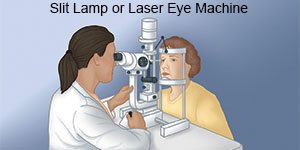Panretinal Photocoagulation
Medically reviewed by Drugs.com. Last updated on May 6, 2024.
What do I need to know about panretinal photocoagulation (PRP)?
PRP is a procedure used to treat leaking blood vessels in the retina. Certain conditions weaken the blood vessels, causing them to leak. Proliferative diabetic retinopathy is the most common condition PRP is used to treat. This condition causes the retina to create new, weak blood vessels that also leak. PRP makes hundreds of tiny burns that seal leaking vessels on the peripheral (outer) part of the retina. New vessels are also prevented from growing. PRP will not give you back lost vision, but it can keep vision loss from getting worse.
 |
How do I prepare for PRP?
- Your healthcare provider will tell you how to prepare. Arrange to have someone drive you home after the procedure. You may need to have more than one treatment. Make sure you arrange to have someone drive you home after each treatment session.
- You may be asked to bring dark sunglasses to your PRP appointment. Your pupils will be dilated (widened) to help your provider see your retina more easily. Your pupils will absorb more harmful sunlight than usual while they are dilated. You will need to wear the dark sunglasses during your ride home. You also need them when you are outside until your pupils go back to their normal size.
- Tell your provider about all medicines you currently take. He or she will tell you if you need to stop any medicine for the procedure, and when to stop. He or she will tell you which medicines to take or not take on the day of the procedure.
What will happen during PRP?
- You may be given local anesthesia as eyedrops or shots to help prevent discomfort. You may still feel a mild ache during the procedure, but you should not feel pain. A contact lens will be placed on your cornea. The lens will keep your eye still and help the laser focus.
- The machine used for the procedure is similar to the machine used during a regular eye exam. You will sit with your chin on the chinrest and your forehead against the headrest. You may be asked to look at a target with the eye that is not being treated. This helps you keep your treated eye where your provider wants it during treatment.
- The laser will be directed at many blood vessels in the peripheral (outer) part of the retina. You may see flashes of bright light during the procedure. Tell your provider if you feel severe pain while the laser is being used. He or she may need to make changes to your procedure.
- Anti-vascular endothelial growth factor (anti-VEGF) treatment may be given to reduce swelling and improve vision. Medicine is injected into the vitreous of the eye. The vitreous is the gel-like material that fills the inside of the eye.
 |
What should I expect after PRP?
- You should be able to return to most activities right away.
- You may feel a mild ache in your eye or see flashes of light for a day or two.
- Your vision may be blurry for up to a week.
- You may have a headache for a few hours.
What are the risks of PRP?
You may have heavy bleeding in your eye, or your retina may become detached (pulled away). You may have temporary or permanent blurred vision, vision loss, double vision, or peripheral vision problems. You may have trouble driving at night. You may not see color or contrast as well as before PRP. Your eyelid may droop. New blood vessels may grow, and you may need PRP to control the growth. PRP can also cause edema that puts pressure on blood vessels. The pressure can cause more leaking that leads to vision loss. You may still lose your vision even with successful PRP.
Care Agreement
You have the right to help plan your care. Learn about your health condition and how it may be treated. Discuss treatment options with your healthcare providers to decide what care you want to receive. You always have the right to refuse treatment. The above information is an educational aid only. It is not intended as medical advice for individual conditions or treatments. Talk to your doctor, nurse or pharmacist before following any medical regimen to see if it is safe and effective for you.© Copyright Merative 2024 Information is for End User's use only and may not be sold, redistributed or otherwise used for commercial purposes.
Further information
Always consult your healthcare provider to ensure the information displayed on this page applies to your personal circumstances.
